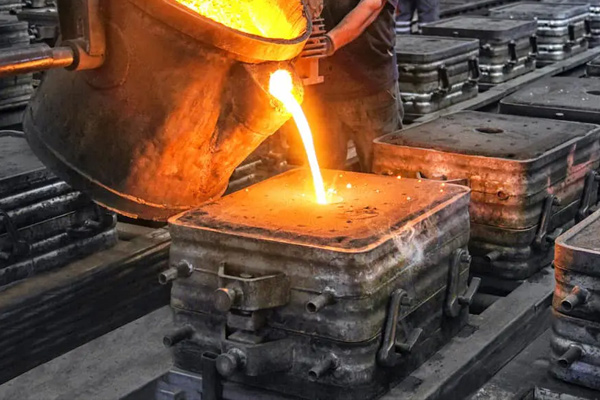Chromite sand for Sand Casting Advantages
Chromite sand is widely recognized as a high-performance refractory material in sand casting, especially for producing high-quality castings (e.g., steel, stainless steel, alloy steel, and large-scale heavy castings). Its advantages stem from its unique physical, chemical, and thermal properties, which address key challenges in sand casting processes. Below are its core advantages of chromite sand for Sand Casting:
1. Exceptional High-Temperature Stability (Refractory Performance)
This is the most critical advantage of chromite sand, making it irreplaceable for casting high-melting-point alloys:
- High refractoriness: Chromite sand has a melting point of ~2,180°C and a service temperature up to 1,600–1,800°C (far higher than common sands like silica sand, which sinters at ~1,200°C). It resists softening, melting, or sintering when in direct contact with molten metals (e.g., steel at 1,500–1,600°C), avoiding defects like sand fusion (molten sand adhering to the casting surface) or mold collapse.
- Low thermal expansion: Its coefficient of thermal expansion is only ~5–8 × 10⁻⁶/°C (much lower than silica sand’s ~12 × 10⁻⁶/°C). This minimizes mold cracking or deformation caused by rapid temperature changes during casting, ensuring the mold maintains its shape to replicate fine casting details.
2. Excellent Chemical Inertness (Resistance to Metal Reaction)
Chromite sand’s stable chemical composition (primarily FeCr₂O₄) prevents adverse reactions with molten metals or casting fluxes, reducing defect risks:
- No reaction with iron-based alloys: Unlike silica sand (SiO₂), which reacts with molten iron to form low-melting-point fayalite (Fe₂SiO₄) (causing metal penetration or scab defects), chromite sand does not react with iron, steel, or most non-ferrous alloys. This keeps the casting surface smooth and reduces post-casting cleaning workload.
- Resistance to slag/flux corrosion: It is inert to acidic, neutral, and weakly alkaline slags generated during casting. This avoids mold erosion by slag, ensuring the mold cavity remains intact and preventing slag inclusions (a major casting defect).
3. Superior Thermal Conductivity & Heat Dissipation
Chromite sand has a thermal conductivity of ~1.5–2.0 W/(m·K) (2–3 times higher than silica sand). This property delivers two key benefits:
- Promotes directional solidification: Faster heat dissipation from the casting surface (via the chromite sand mold) encourages the molten metal to solidify uniformly from the outside in. This reduces internal defects like shrinkage cavities or porosity (critical for thick-walled or heavy castings).
- Shortens casting cycle: Faster cooling speeds up the solidification process, reducing the time needed for mold stripping and casting processing—improving production efficiency, especially for mass or large-scale casting.
4. High Density & Mold Stability
As noted earlier, chromite sand has a true specific gravity of 4.2–4.8 g/cm³ (much higher than silica sand’s ~2.65 g/cm³). This high density enhances mold performance:
- Resists “scouring” by molten metal: The dense sand particles are less likely to be washed away (scoured) by the high-velocity flow of molten metal during pouring. This prevents sand inclusions (a defect where loose sand particles become trapped in the casting).
- Tight mold packing: High-density sand packs more tightly in the mold, reducing voids between particles. This improves mold rigidity, prevents mold wall movement during casting, and ensures accurate replication of the casting’s dimensions (high dimensional precision).
5. Good Reusability (Cost-Effectiveness)
Chromite sand retains its physical and chemical properties well after use, making it highly recyclable:
- Low attrition rate: Its high hardness (Mohs hardness ~5.5–6.5) reduces particle breakage during mold making, stripping, and recycling. Even after multiple cycles, the sand’s particle size and shape remain stable.
- Minimal post-use treatment: Recycled chromite sand only requires simple screening (to remove impurities) or light reconditioning (e.g., adding small amounts of fresh sand) to meet reuse standards. This lowers raw material costs compared to single-use sands (e.g., zircon sand, which is more expensive and less recyclable).
6. Suitable for Special Casting Processes
Chromite sand’s properties make it ideal for demanding casting methods:
- Investment casting (lost-wax casting): It can be used as a refractory filler in shell molds to enhance high-temperature resistance, critical for precision castings (e.g., aerospace components).
- Large-scale sand casting: For heavy castings (e.g., engine blocks, turbine housings), its mold stability and heat dissipation prevent deformation and internal defects.
In summary, chromite sand’s combination of high refractoriness, chemical inertness, thermal conductivity, and reusability makes it a preferred choice for sand casting applications where casting quality, process stability, and cost-efficiency are critical—especially for high-temperature alloys and large, precision castings.
















